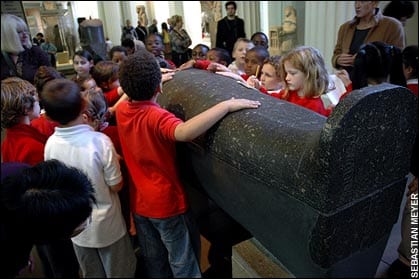Question of the Week: Why can’t I touch museum objects?
By Stacy Hackner, on 19 August 2015
For humans, touch is an important way to gain information about an object. We can tell if something is soft or hard, heavy or light, smooth or rough or fluffy, pliable, sharp, irregular. During my masters class on human dentition, I learned to identify teeth by touch to get around visual biases. We spent a significant amount of time touching objects in our environment, so we tend to get angry when museums tell us not to touch the objects.
I understand the desire to touch a piece of history. There’s a feeling of authenticity you get from holding something made by ancient people, and a sense of disappointment if you’re told the artifact is actually a replica. A British Museum visitor commented that “It was just lovely to know that you could pick something up that was authentic. It was just lovely to put your hands on something.” Another said “You do think sometimes when you’re looking in the cases, sometimes I’d like to pick that up and really look closely.”[i]
Even with “no touching” signs, museum visitors continue to touch things. Sometimes it’s by accident and sometimes they get a sneaky look on their faces, knowing they’re ignoring the signs; most often, they don’t realize what they’re doing is damaging the object.
Passive conservation of an object involves creating a stable environment so that the object can continue its “life” undisturbed. Sudden changes in humidity, temperature, and light can degrade the object. Touching it introduces dirt and oils from your skin onto its surface – the same way you’d leave fingerprints at a crime scene. Additionally, the oils can then attract dirt to linger, and acidic oils can also degrade metallic surfaces.
Yes, museum professionals handle objects for research purposes. However, we attempt to handle them as little as possible with clean hands and wear gloves when appropriate. This difference between museum staff and the public is also one of quantity: it’s ok if one person does it occasionally, but if everyone touches it on every visit, the grime adds up. In 2009, the Ashmolean Museum in Oxford introduced a “touchometer” that counts how many people have touched an object made of various materials. As you can see in the image below, after nearly 8 million touches, the left half of the object is severely degraded. The stone (centre) has developed a patina, the metal (bottom) has become shiny, and the cloth (left) has entirely worn away. (Also, people have scratched the frame.)
If you walk through the British Museum’s gallery of Egyptian statuary, you can clearly see the areas on artifacts that people like to touch – the corners and public-facing edges of sarcophaguses are darker than the wall-facing edges, and anything round and protruding tends to have a sheen that takes years of painstaking work to remove (hands, feet, and breasts of statues at human height are particularly vulnerable).

Schoolchildren touch a sarcophagus. Credit: Sebastian Meyer for The Telegraph.
The Grant Museum has specific objects that can be handled, and UCL Museums have object-based learning programs to introduce students and specific groups to handling museum objects. [ii] Many other museums have touch tables or touch sessions where you can feel the weight of hand axes or porcupine quills. Don’t despair if you’re asked not to touch something in a museum – we’re not angry, we just want to make sure they’re preserved for future museum visitors to enjoy.
Sources
[i] Touching History: An evaluation of Hands On desks at The British Museum. 2008. Morris Hargreaves Mcintyre.
[ii] UCL Museums Touch & Wellbeing; Object-Based Learning
Conservation Advice – Handling Museum Objects. 2015. Southeast Museums.
 Close
Close






